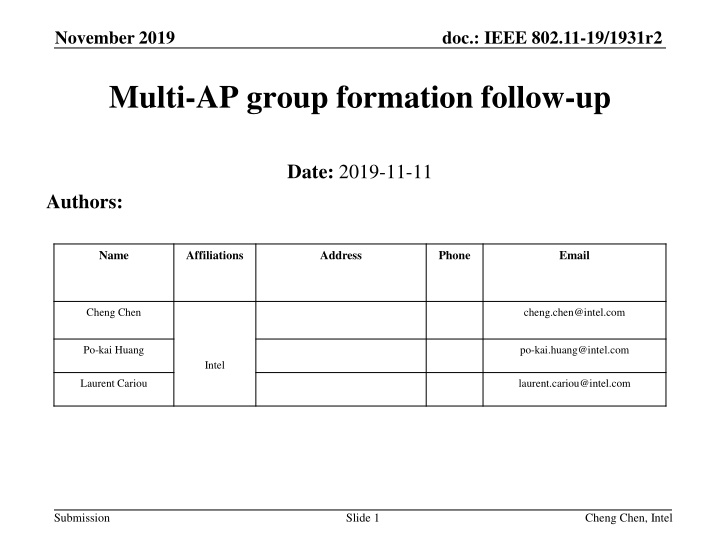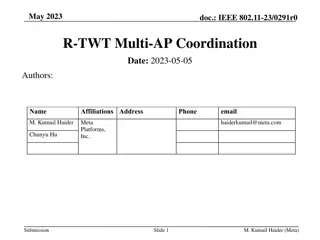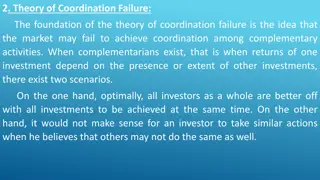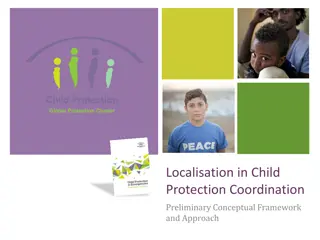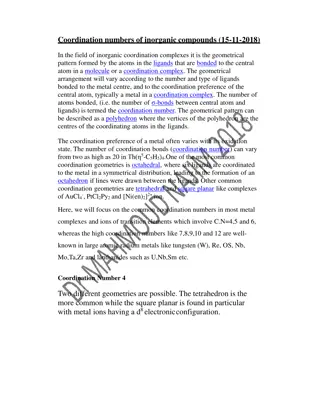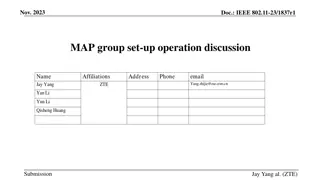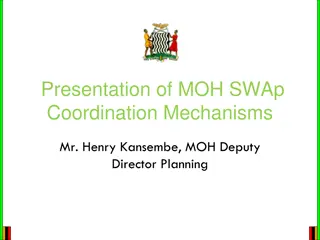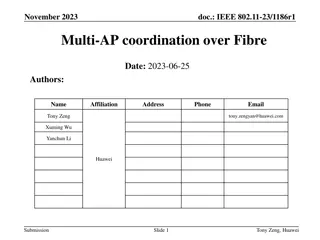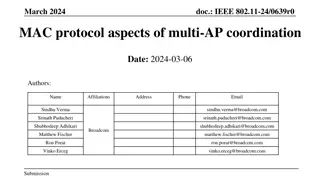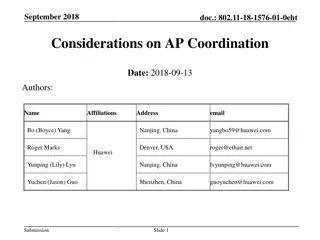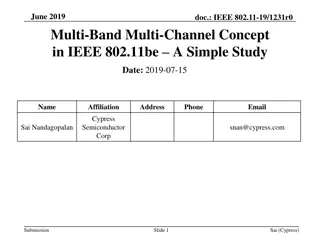Multi-AP Coordination Framework
This document explores the motivation and framework for Multi-AP coordination in IEEE 802.11 networks, focusing on the formation of AP groups, boundary definitions, triggering operations, and system optimization.
Download Presentation

Please find below an Image/Link to download the presentation.
The content on the website is provided AS IS for your information and personal use only. It may not be sold, licensed, or shared on other websites without obtaining consent from the author.If you encounter any issues during the download, it is possible that the publisher has removed the file from their server.
You are allowed to download the files provided on this website for personal or commercial use, subject to the condition that they are used lawfully. All files are the property of their respective owners.
The content on the website is provided AS IS for your information and personal use only. It may not be sold, licensed, or shared on other websites without obtaining consent from the author.
E N D
Presentation Transcript
doc.: IEEE 802.11-19/1931r2 November 2019 Multi-AP group formation follow-up Date: 2019-11-11 Authors: Name Affiliations Address Phone Email Cheng Chen cheng.chen@intel.com Po-kai Huang po-kai.huang@intel.com Intel Laurent Cariou laurent.cariou@intel.com Submission Slide 1 Cheng Chen, Intel
doc.: IEEE 802.11-19/1931r2 November 2019 Motivation In [1], we initiated discussions on the fundamental framework of Multi-AP coordination, i.e., the formation of a set of APs that will participate in Multi- AP transmissions. We proposed that we need the concept of a Multi-AP set. However, the specific procedures of how to form the Multi-AP set, could be implementation specific, and therefore outside of the scope of 11be. This contribution further investigates Multi-AP group formation. Submission Slide 2 Cheng Chen, Intel
doc.: IEEE 802.11-19/1931r2 November 2019 Multi-AP coordination The primary motivation for Multi-AP feature is to leverage the coordination among multiple APs to optimize a system-level metric, such as overall throughput or average latency. In order to achieve the Multi-AP benefits, both long-term management domain coordination and specific triggering functions are needed. The long-term coordination basically includes management functions such as defining the boundary of Multi-AP functions and general operation rules. The specific triggering operations depend on different Multi-AP coordination techniques, such as conducting sounding sequence for coordinated/joint BF, initiating coordinated OFDMA transmission, and performing joint transmission. Submission Slide 3 Cheng Chen, Intel
doc.: IEEE 802.11-19/1931r2 November 2019 Boundary of Multi-AP operations When designing protocols for various Multi-AP coordination functions, we should clearly define the boundary of these coordination functions. In legacy Single AP scenario, most of the functions between the AP and its associated STAs are limited to its own BSS. In Multi-AP scenarios, we should also limit the Multi-AP functions within a defined boundary. This basically means we need a way to indicate if an AP can be coordinated by another AP or not. For example, we may not want to allow the case that an AP in my neighbor s home is able to coordinate the AP in my own home arbitrarily. In this case, a group concept is needed to define this boundary and place restrictions on the potential candidates of Multi-AP transmissions. Similar to the concept of SRG group defined in 11ax. If we want to enable the authentication of Multi-AP Trigger frames, including a way to distribute the key for authenticating and verifying the Multi-AP trigger frames sent among a certain set of APs, a group concept is also needed. Prevention from DoS attacks. Slide 4 Submission Cheng Chen, Intel
doc.: IEEE 802.11-19/1931r2 November 2019 Triggering operation For each AP that participates in Multi-AP functions, there should be a way to indicate if it can initiate the coordination and trigger the other APs or not. Mode 1: Every AP can initiate and trigger coordination For example, any AP that has obtained a TXOP can initiate coordinated OFDMA with other APs [2]. Mode 2: Only certain AP(s) can initiate and trigger the coordination operation Suitable in scenarios where fully scheduled/trigger-based access is preferred. Submission Slide 5 Cheng Chen, Intel
doc.: IEEE 802.11-19/1931r2 November 2019 Example of every AP can initiate coordination operations Multi-AP Trigger DL OFDMA UL Ack/BA Frequency STA STA STA STA AP1 AP2 STA Time TXOP 1, obtained by AP1 STA Frequency Multi-AP Trigger UL OFDMA DL Ack/BA Trigger STA AP3 AP4 STA STA Time TXOP 2, obtained by AP3 Submission Slide 6 Cheng Chen, Intel
doc.: IEEE 802.11-19/1931r2 November 2019 Overall proposal We propose the following Multi-AP framework: 1. Introduce the concept of a Multi-AP set consisting of APs that may participate in Multi-AP transmission. However, we do not need to define specific formation procedures of a Multi-AP set. 2. Define a mechanism to determine whether an AP is part of a Multi-AP set that participates in Multi-AP transmission. 3. For specific triggering operations, there may be different modes depending on whether an AP can initiate and trigger coordination operations or not. Submission Slide 7 Cheng Chen, Intel
doc.: IEEE 802.11-19/1931r2 November 2019 Straw Poll Do you agree with the following? 11be shall define a mechanism to determine whether an AP is part of an AP candidate set and can participate as a shared AP in Coordinated AP transmission initiated by a sharing AP. Submission Slide 8 Cheng Chen, Intel
doc.: IEEE 802.11-19/1931r2 November 2019 References [1] 11-19-1616-01-00be-multi-ap-group-formation [2] 11-19-1582-00-00be-introduction-to-coordinated-ap- ofdma-transmissions-in-11be Submission Slide 9 Cheng Chen, Intel
